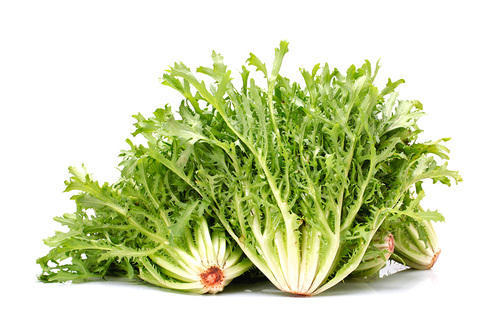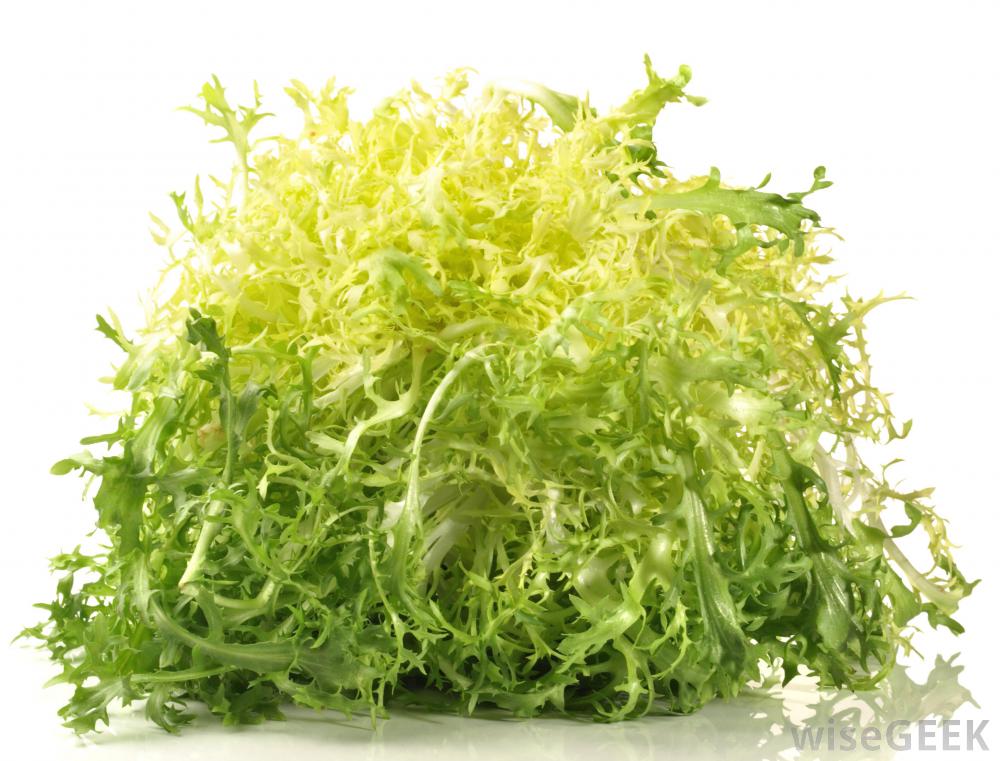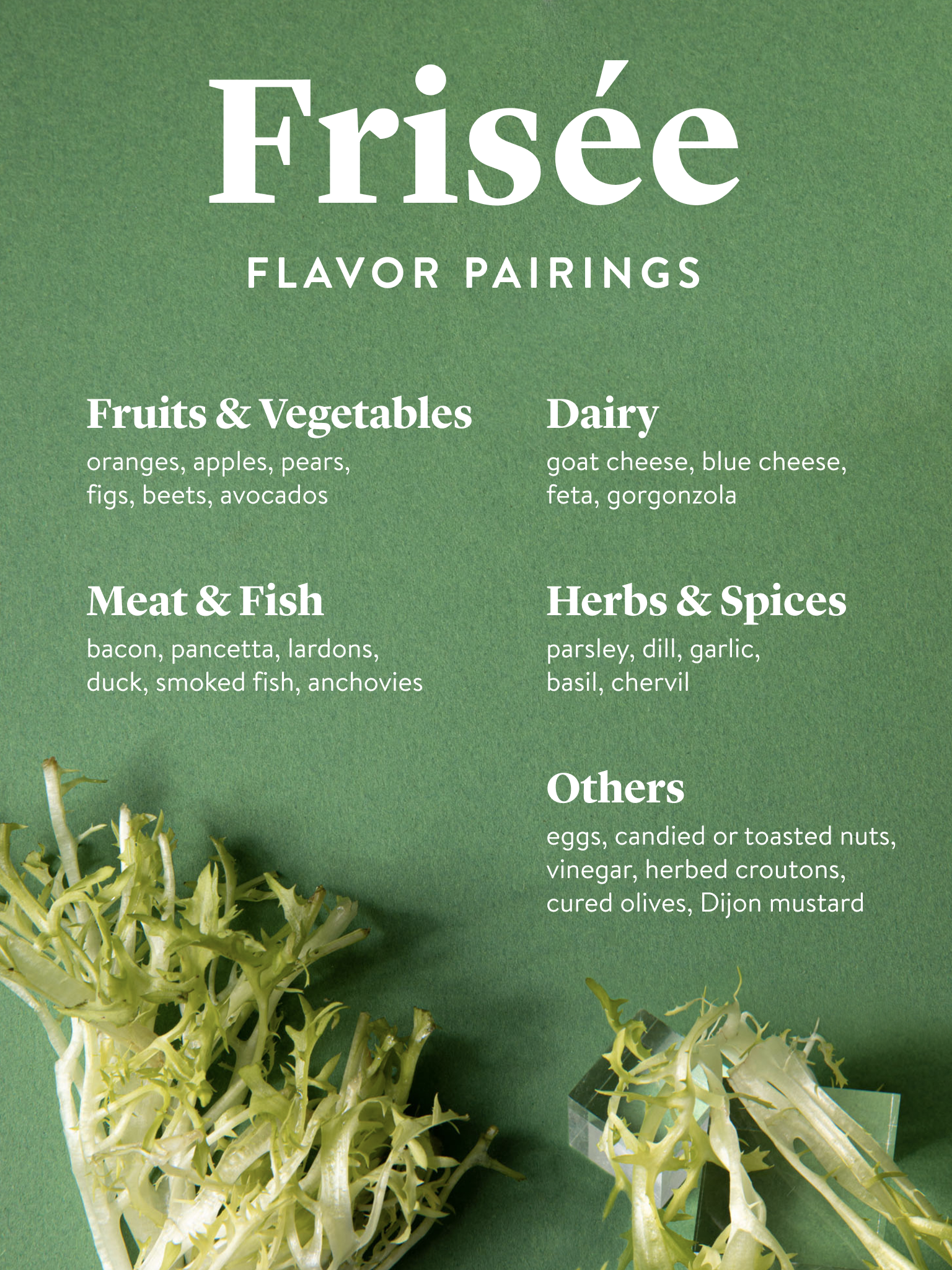Frisée, also known as curly endive, is a frizzy salad green of the chicory family. The most noticeable characteristic of this vegetable is its appearance: a tousled head of dark lacy ruffles, sprouting from a pale yellow core. But frisée is more than just an aesthetic choice, it’s also saturated with a bright bitterness and nutty notes, which can really deepen and enrich a dish’s palate.
As with most leafy greens, frisée contains very few calories and a whole lot of beneficial nutrients. A single serving contains 30% of the daily recommended intake of folic acid, eyesight-boosting vitamin A, and immune-supporter vitamin C. It’s also a fantastic source of dietary fibre, manganese, iron, and potassium.
The frilly fronds of this chef-favoured lettuce are bitter with a satisfying crunch, so if you’re feeling a little underwhelmed by your everyday mix of spinach or arugula, look no further than frisée to add dimension and texture to your salads and sandwiches.

To get the most out of frisée, don’t wash it until it’s ready to be eaten. If there are any signs of mild wilting, you can soak the frisée in cold water for approx. 15 min. to revitalize the leaves. Bear in mind these curlicues retain water like sponges, so definitely use a salad spinner after soaking them! Despite its hardiness, frisée’s curls are extremely delicate and we suggest tearing the leaves into bite-sized pieces by hand rather than running a knife through them, which flattens the leaves’ natural shape. Store fresh frisée in a ventilated bag in the crisper drawer of the fridge for up to one week.
Due to its sharp taste, frisée isn’t everyone’s cup of tea, but this shouldn’t deter you from cooking with it! There are many ways to allay the bitterness and it all rests on how you dress it. Luckily, frisée is super susceptible to intense flavours and does really well with salty cheeses and citrus fruits. To enhance the nutty flavours of frisée, throw pecans or walnuts into the mix.
Since the inner yellow leaves are delicate and sweeter than the outer leaves, we like to reserve them for salads or placed under freshly grilled fish, meat, or veg. Pair your frisée salad with a sweet and acidic dressing—like maple syrup and red wine vinegar—and toss in some milder greens such as romaine or arugula to soften the bitter bite. Remember: frisée is hardy, so it can handle heavy and creamy dressings without wilting or becoming mushy.
Sauté the darker, outer leaves with a dash of maple syrup and lemon or animal fat to round out the flavours. Although its tousled leaves can withstand the weight of heavy sauces, frisée cooks quite quickly, so be sure to keep an eye on the pan, and, if cooking it in a soup or stew, toss in these curly-haired babies last.

Source:
Mary-Linh Tran Junior Food Editor at Kitchen Stories https://www.kitchenstories.com/en/stories/everything-to-know-about-cooking-and-shopping-for-in-season-frisee-lettuce
As with most leafy greens, frisée contains very few calories and a whole lot of beneficial nutrients. A single serving contains 30% of the daily recommended intake of folic acid, eyesight-boosting vitamin A, and immune-supporter vitamin C. It’s also a fantastic source of dietary fibre, manganese, iron, and potassium.
The frilly fronds of this chef-favoured lettuce are bitter with a satisfying crunch, so if you’re feeling a little underwhelmed by your everyday mix of spinach or arugula, look no further than frisée to add dimension and texture to your salads and sandwiches.

To get the most out of frisée, don’t wash it until it’s ready to be eaten. If there are any signs of mild wilting, you can soak the frisée in cold water for approx. 15 min. to revitalize the leaves. Bear in mind these curlicues retain water like sponges, so definitely use a salad spinner after soaking them! Despite its hardiness, frisée’s curls are extremely delicate and we suggest tearing the leaves into bite-sized pieces by hand rather than running a knife through them, which flattens the leaves’ natural shape. Store fresh frisée in a ventilated bag in the crisper drawer of the fridge for up to one week.
Due to its sharp taste, frisée isn’t everyone’s cup of tea, but this shouldn’t deter you from cooking with it! There are many ways to allay the bitterness and it all rests on how you dress it. Luckily, frisée is super susceptible to intense flavours and does really well with salty cheeses and citrus fruits. To enhance the nutty flavours of frisée, throw pecans or walnuts into the mix.
Since the inner yellow leaves are delicate and sweeter than the outer leaves, we like to reserve them for salads or placed under freshly grilled fish, meat, or veg. Pair your frisée salad with a sweet and acidic dressing—like maple syrup and red wine vinegar—and toss in some milder greens such as romaine or arugula to soften the bitter bite. Remember: frisée is hardy, so it can handle heavy and creamy dressings without wilting or becoming mushy.
Sauté the darker, outer leaves with a dash of maple syrup and lemon or animal fat to round out the flavours. Although its tousled leaves can withstand the weight of heavy sauces, frisée cooks quite quickly, so be sure to keep an eye on the pan, and, if cooking it in a soup or stew, toss in these curly-haired babies last.


Source:
Mary-Linh Tran Junior Food Editor at Kitchen Stories https://www.kitchenstories.com/en/stories/everything-to-know-about-cooking-and-shopping-for-in-season-frisee-lettuce


Leave A Comment